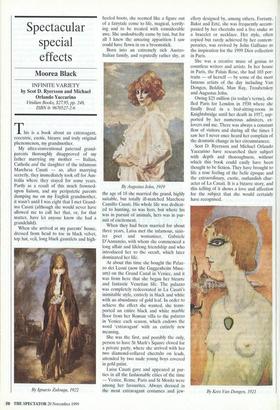Spectacular special effects
Moorea Black INFINITE VARIETY by Scot D. Ryersson and Michael Orlando Yaccarino Viridian Books, $27.95, pp. 248, ISBN 0- 9670527-2-6 This is a. book about an extravagant, eccentric, exotic, bizarre and truly original phenomenon, my grandmother.
My ultra-conventional paternal grand- parents thoroughly disapproved of my father marrying my mother — Italian, Catholic and the daughter of the infamous Marchesa Casati — so, after marrying secretly, they immediately took off for Aus- tralia where they stayed for some years. Partly as a result of this much frowned- upon liaison, and my peripatetic parents dumping me on my English grandmother, it wasn't until I was eight that I met Grand- ma Casati (although she would never have allowed me to call her that, or, for that matter, have let anyone know she had a grandchild).
When she arrived at my parents' house, dressed from head to toe in black velvet, top hat, veil, long black gauntlets and high-
By Ignacio Zuloaga, 1922
heeled boots, she seemed like a figure out of a fairytale come to life, magical, terrify- ing and to be treated with considerable awe. She undoubtedly came by taxi, but for all I knew the amazing apparition I saw could have flown in on a broomstick.
Born into an extremely rich Austro- Italian family, and reputedly rather shy, at
By Augustus John, 1919
the age of 18 she married the grand, highly suitable, but totally ill-matched Marchese Camillo Casati. His whole life was dedicat- ed to hunting, so was hers, but where his was in pursuit of animals, hers was in pur- suit of excitement.
When they had been married for about three years, Luisa met the infamous, sinis- ter poet and womaniser, Gabriele D'Annunzio, with whom she commenced a long affair and lifelong friendship and who introduced her to the occult, which later dominated her life.
At about this time she bought the Palaz- zo dei Leoni (now the Guggenheim Muse- um) on the Grand Canal in Venice, and it was from here that she began her bizarre and fantastic Venetian life. The palazzo was completely redecorated in La Casati's inimitable style, entirely in black and white with an abundance of gold leaf. In order to achieve the effect she wanted, she trans- ported an entire black and white marble floor from her Roman villa to the palazzo in Venice each season, which endows the word 'extravagant' with an entirely new meaning.
She was the first, and possibly the only, person to have St Mark's Square closed for a private party, where she arrived with her two diamond-collared cheetahs on leads, attended by two nude young boys covered in gold paint.
Luisa Casati gave and appeared at par- ties in all the fashionable cities of the time — Venice, Rome, Paris and St Moritz were among her favourites. Always dressed in the most extravagant costumes and jew- ellery designed by, among others, Fortuny, Bakst and Ertd, she was frequently accom- panied by her cheetahs and a live snake as a bracelet or necklace. Her style, often copied but rarely achieved by her contem- poraries, was revived by John Galliano as the inspiration for the 1999 Dior collection in Paris.
She was a creative muse of genius to countless writers and artists. In her house in Paris, the Palais Rose, she had 103 por- traits — of herself — by some of the most famous artists of the day including Van Dongen, Boldini, Man Ray, Troubetskoy and Augustus John.
Owing $25 million (in today's terms), she fled Paris for London in 1930 where she finally lived in a bed-sitting-room in Knightsbridge until her death in 1957, sup- ported by her numerous admirers, ex- lovers and me. There was always a constant flow of visitors and during all the times I saw her I never once heard her complain of the dramatic change in her circumstances.
Scot D. Ryersson and Michael Orlando Yaccarino have researched their subject with depth and thoroughness, without which this book could easily have been thought to be fiction. They have brought to life a true feeling of the belle epoque and the extraordinary, exotic, outlandish char- acter of La Casati. It is a bizarre story, and this telling.of it shows a love and affection for the subject that she would certainly have recognised.
By Kees Van Dongen, 1921


























































































 Previous page
Previous page